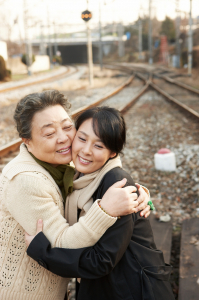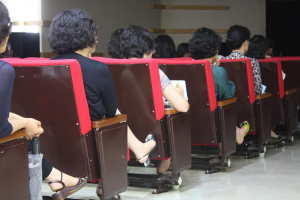Compromise between work and childcare
WITH WHOM do you talk the most? According to a survey conducted in January 2008 by a part-time job portal site, www.albamon.com, nearly half of the respondents among 1,012 college students answered "mother". Today, college students face difficulties in keeping up with their hectic workloads, pressured by a society in which one receives recognition only by surviving cut-throat competition. In the midst of such adversity, students often miss their mothers warm back-up. A mother occupies an important part of these students lives, and is also the one who most affects them. With the rise of this particular keyword in the mainstream media, The Yonsei Annals tried to find an answer to such phenomena and find out more about the diverse aspects and circumstances that Korean mothers face.

The stereotypical image of a Korean mother
Shin Saim-dang is known as the first woman to practice pre-natal care in Korean history, and is remembered as the representative Korean figure of a good wife and wise mother. Interestingly enough, she is also the first woman chosen to be printed on the new ₩50,000 bill, despite numerous controversies. "There were even some progressive feminist organizations that polled against, claiming that she is too conservative a woman figure to be a modern female role model," claims Kim Tae-jin (Prof., Dept. of Economics). Despite Lee Yi, Shin's son, being printed on the ₩5,000 note, printing her this time on the newly issued bill implies that women hold significance in society. Mothers contribute positively in the family and society by educating their children.
The word "mother" possesses diverse connotations. Especially in Korean society, though, the mother figure during the last few decades is a very stereotypical, conservative image. Sacrifice and endless love without anything in return is the motto people have in mind. Furthermore, mothers in the past spent most of their time at home, taking care of house chores and children's education. Their abilities as a good mother were assessed by how well they carried out the central task of educating their children.
However, recently, in the cultural sphere, the subject of a "mother" is being used in diverse ways. The novels Take Care of My Mother by Shin Kyung-sook and Whatever Life You Live, I Will Always Support You by Gong Ji-young are both bestsellers that tackle the typical, devoted mother figure. The intriguing fact is that, today, the mother figure that most people, especially women, pursue is the modern working mother figure with her own interests. However, children still identify with the stereotypical and traditional mother figure. A review of the play 2 Nights, 3 Days with Mom by Park Dong-gyu (Reporter, Chosun Daily) notes, "the audience seemed as if they came with the intention to cry; it was a stale, common play but instead of resisting, the audience willingly participated in the tears." Such phenomena can be explained by the social and economic instability that causes people to have nostalgia for the secure, consoling mother's bosom.
The keyword "mother" is often brought up during economic depressions, as well as cultural stagnations. Indeed, the mother figure has a very personal meaning for each one of us, but, at the same time, it has a public and commonly shared significance. "During difficult times, people tend to bring up the past and old-fashioned values. This is how the market takes advantage through its nostalgia-marketing strategy," claims Kim Hun (Deputy Director, Institute for Korean Cultural Strategy). In addition, when there is a lack of new and fresh subjects, the theme of "mother" is brought up as a solution because it is something everyone is familiar with, and has a positive view on. Thus, the word "mother" seems to be reminiscent of warmth and affiliation to everyone.

Korean mothers today
As shown in the media, today's mother figure among the younger generation is the capable and working mother. Indeed, in TV drama series, women as mothers are depicted as active mothers who do not overwhelm themselves with their children's lives, and fulfill their own independent interests. Today, with the economic recession, mothers have begun working like fathers to ensure a stable family income. However, most people might think, mothers are still "mothers". Women as mothers did evolve in their social class and do have a job of their own. Furthermore, they are less bound to the house chores-husband-children triangle and actually live as women in search of their identity. Nonetheless, the mother figure depicted in today's TV series does not necessarily reveal the many roles of a mother in the real world.
There are significant economic and social reasons behind the apparent emergence of women. "What matters the most today in Korean society is education. How well a mother educates a child is definitely one of the criteria imposed by the society in determining a 'good and successful mother'," says Jeong Jin-ho (Prof., Dept of Economics). Indeed, post-modernism has boosted the fierce competition that leads to the widening of the social gap. The only viable way for a family to climb up the social ladder seems to be through education, or more precisely, the offspring getting into a prestigious university. The person who takes care of the child and makes sure that he or she gets into one of those universities is none other than the mother. "Formerly, students could get into a good university just by having good grades, whereas, today, with the adoption of the Admission Office System, students need not only high scores but other certificates and extracurricular activities as well. This will definitely increase mothers' responsibilities and workloads because they are the ones who support the children in getting prepared," claims Chang Won (Prof., Dept. of Sociology). Unlike the common view that mothers in today's society are much freer from child care, they are rather forced to contribute to the family income and take care of children's education at the same time, making their responsibilities heavier, in fact.
The reaction to mothers' importance and roles today
The acceleration of modernization and liberalism causes individualism to grow stronger. Relationships with one another tend to become superficial - deep and private conversations are less often established. This often leads people to turn to family bonds, emphasizing the importance of the mother-to-son or mother-to-daughter relationship. The movie Mother by Bong Joon-ho has attracted much interest and a wide audience. It depicts a retro-mother icon who is at her son's side at all times. "We are living in a cold and tough society that produces lonely individuals. In the processes of globalization and liberalism, people want to go beyond superficial relationships based on materials goals. They yearn for a new kind of affiliation, different from one based on social factors such as pure love, true friendship, or religious belief," states Chang. People increasingly miss and desire the unconditional love they used to receive from their mother because it is hard to experience in contemporary society.
However, what each individual expects from his or her mother can be diverse. Mothers may overwhelm their children with excessive expectations or attention, and things can turn out in a way they did not intend. For example, recently, the appearance of "Anti-Mother Caf? on the internet aroused many controversies. Ironically enough, the mother figure, which has been strongly rooted in people's mind as the most loving and devoted character, has been redefined as an evil and harmful image to some. The internet cafe was opened by a teenager, and apparently many people joined it, posting shocking and harsh comments and criticisms. The self-explanatory title reveals the new-found phenomenon of children criticizing their own mothers. This was a great shock to Korean society, especially to the older generation completely immersed in the stereotypical image of mothers. Viewing the issue from an alternative perspective, this has been an opportunity to refocus on the theme of the "mother". This theme had started to become too stale in the cultural industry and such controversies succeeded in regaining popular attention. The stereotypical concept of the "mother" has been challenged, and this may help to shape the changing image of mothers in contemporary Korean culture and society.
Towards a new mother figure
The mother figure has changed over the years. However, the core meaning and significance of it have not been altered. People may have a slightly different understanding of their own mother figure. Nevertheless, both the stereotypical and modern images show the same type of devotion and absorption.
Korean society has shifted into a female-oriented generation. "Today, instead of an industrialized society, we are moving toward a society which bases its assessment on feminine values. Emotional and sentimental values are preferred over rational and logical values," explains Chang. Moreover, with the increase in the number of unmarried mothers and single mothers keeping their children, there is a need to invest in mothers and children by providing them with welfare systems and policies. Likewise, mothers who decide or choose to be the primary care givers of children by giving up their work for some years should be free from any threat of social or economic penalties. The government should implement programs so that mothers can get back to work when they decide to. Even though their work may be unpaid and not calculated in the countries' GDP, it should still be recognized, respected, and valued.
Because mothers in the past often did not receive a high level of education, their only hope and way to overcome their situation was achieving their dreams by proxy. Today, mothers fulfill their duties and responsibilities in a different way. The self-sacrificing mother image is no more the norm. Mothers live as independent women and want to be role models for their children. Such a trend can be observed through the lives of female stars, as they often serve as role models for their audience. In the past, it was difficult for female stars to maintain their fame and position after becoming mothers. However, today, even single mothers can make a comeback, sometimes with an even more appealing image.
There are organizations whose purpose is to help mothers to accomplish their responsibilities to the fullest. The Korean National Mothers' Association (KNMA), established in 1958, provides such support. Their motto, "A strong state originates from wise mothers; the hand waving the blanket shakes the world," is very symbolic. "To fulfill the central role and task of the society, there are diverse activities implemented for mothers. Lectures are provided for the mothers who want to learn, and there are also diverse volunteer services that they can participate in. But above all, educating mothers to have the right mindset and find their true identity as mothers is emphasized," claims Kang Eun-sung (President, KNMA). There are different attempts to shape the right mother figure in diverse ways. Hence, there is no absolute definition of an ideal mother. Mothers with different assessments and values are appealed to according to the contemporary social atmosphere.
* * *
It is time for Korean society to escape from the stereotypical view of mothers depicted in the mass media as either the forced victim or the savior. The image of mothers has changed gradually over the years. Each different period in which a society and its economic circumstances develop determines a certain type of mother figure. This figure should remain flexible according to society's requirements, but still should not lose its core value. Instead of being passive and letting society craft the new century's mother figure, young people of today's generation should actively participate and struggle to find the right and proper image that a mother should represent. The mother figure is not a fixed concept, but is rather becoming diversified and flexible. Mothers need support in finding their true identities, free from externally-imposed, stereotypical constraints. The question to ask is: how are we going to make the 21st century mother appear?

